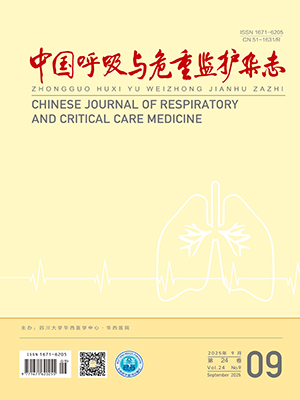| 1. |
Vanhorebeek I, Latronico N, Van den Berghe G. ICU-acquired weakness. Intensive Care Med, 2020, 46(4): 637-653.
|
| 2. |
Mayer KP, Thompson ML, Montgomery AA, et al. Acute skeletal muscle wasting and dysfunction predict physical disability at hospital discharge in patients with critical illness. Crit Care, 2020, 24(1): 637.
|
| 3. |
Fazzini B, Märkl T, Costas C, et al. The rate and assessment of muscle wasting during critical illness: a systematic review and meta-analysis. Crit Care, 2023, 27(1): 2.
|
| 4. |
Chen J, Chen XY, Cong XX, et al. Cellular senescence implicated in sepsis-induced muscle weakness and ameliorated with metformin. Shock, 2023, 59(4): 646-656.
|
| 5. |
Rocheteau P, Chatre L, Briand D, et al. Sepsis induces long-term metabolic and mitochondrial muscle stem cell dysfunction amenable by mesenchymal stem cell therapy. Nat Commun, 2015, 6: 10145.
|
| 6. |
王银燕, 施荣华, 林志敏, 等. 慢性阻塞性肺疾病患者机械通气撤机前膈肌收缩功能的研究. 中国呼吸与危重监护杂志, 2019, 18(5): 423-426.
|
| 7. |
Bonaldo P, Sandri M. Cellular and molecular mechanisms of muscle atrophy. Dis Model Mech, 2013, 6(1): 25-39.
|
| 8. |
Stana F, Vujovic M, Mayaki D, et al. Differential regulation of the autophagy and proteasome pathways in skeletal muscles in sepsis. Crit Care Med, 2017, 45(9): e971-e979.
|
| 9. |
Vasudevan SO, Behl B, Rathinam VA. Pyroptosis-induced inflammation and tissue damage. Semin Immunol, 2023, 69: 101781.
|
| 10. |
Chen X, Lin S, Dai S, et al. Trimetazidine affects pyroptosis by targeting GSDMD in myocardial ischemia/reperfusion injury. Inflamm Res, 2022, 71(2): 227-241.
|
| 11. |
Wang L, Jiao XF, Wu C, et al. Trimetazidine attenuates dexamethasone-induced muscle atrophy via inhibiting NLRP3/GSDMD pathway-mediated pyroptosis. Cell Death Discov, 2021, 7(1): 251.
|
| 12. |
Zhang J, Wang M, Hu X, et al. Electroacupuncture-driven endogenous circulating serum exosomes as a potential therapeutic strategy for sepsis. Chin Med, 2023, 18(1): 106.
|
| 13. |
Nair AB, Jacob S. A simple practice guide for dose conversion between animals and human. J Basic Clin Pharm, 2016, 7(2): 27-31.
|
| 14. |
Lin JQ, Wang JX, Yu S, et al. Newly discovered molecules associated with trimetazidine on improvement of skeletal muscle function in aging: evidence from myoblasts and mice. Exp Gerontol, 2022, 161: 111733.
|
| 15. |
Wu DD, Pan PH, Liu B, et al. Inhibition of alveolar macrophage pyroptosis reduces lipopolysaccharide-induced acute lung injury in mice. Chin Med J (Engl), 2015, 128(19): 2638-45.
|
| 16. |
Witteveen E, Hoogland IC, Wieske L, et al. Assessment of intensive care unit-acquired weakness in young and old mice: an E. coli septic peritonitis model. Muscle Nerve. 2016, 53(1): 127-33.
|
| 17. |
Stevens RD, Marshall SA, Cornblath DR, et al. A framework for diagnosing and classifying intensive care unit-acquired weakness. Crit Care Med, 2009, 37(10 Suppl): S299-S308.
|
| 18. |
Latronico N, Bolton CF. Critical illness polyneuropathy and myopathy: a major cause of muscle weakness and paralysis. Lancet Neurol, 2011, 10(10): 931-941.
|
| 19. |
Wang W, Xu C, Ma X, et al. Intensive care unit-acquired weakness: a review of recent progress with a look toward the future. Front Med (Lausanne), 2020, 7: 559789.
|
| 20. |
卢娇, 梁国鹏, 王波, 等. 重症加强治疗病房有创机械通气患者早期肺康复研究进展. 中国呼吸与危重监护杂志, 2021, 20(11): 831-836.
|
| 21. |
Chen J, Huang M. Intensive care unit-acquired weakness: recent insights. J Intensive Med, 2023, 4(1): 73-80.
|
| 22. |
Zou W, Liu F, Li J, et al. Current status for animal models of intensive care unit acquired muscle weakness. Chinese, 2018, 43(6): 691-696.
|
| 23. |
Li S, Wu Y, Yang D, et al. Gasdermin D in peripheral myeloid cells drives neuroinflammation in experimental autoimmune encephalomyelitis. J Exp Med, 2019, 216(11): 2562-2581.
|
| 24. |
Xiao J, Wang C, Yao JC, et al. Gasdermin D mediates the pathogenesis of neonatal-onset multisystem inflammatory disease in mice. PLoS Biol, 2018, 16(11): e3000047.
|
| 25. |
Chhetri JK, Fougère B, Rolland Y, et al. Chronic inflammation and sarcopenia: a regenerative cell therapy perspective. Exp Gerontol, 2018, 103: 115-123.
|
| 26. |
Shi J, Zhao Y, Shao F, et al. Cleavage of GSDMD by inflammatory caspases determines pyroptotic cell death. Nature, 2015, 526(7575): 660-665.
|
| 27. |
Song M, Chen FF, Li YH, et al. Trimetazidine restores the positive adaptation to exercise training by mitigating statin-induced skeletal muscle injury. J CACHEXIA SARCOPENI, 2018, 9(1): 106-118.
|




